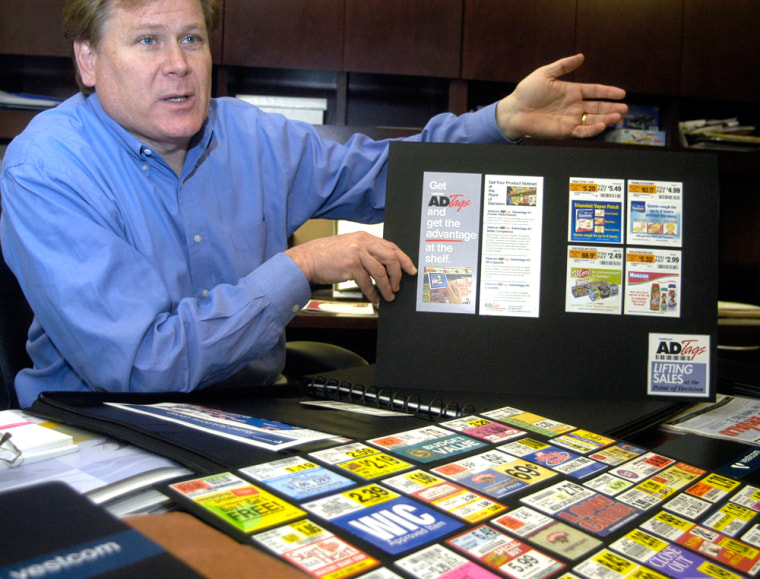Shelf space. For retailers worried that their advertisements are reaching smaller audiences, it’s the final frontier.
Retailers are losing their traditional television audiences to cable, their radio listeners to satellite services and newspaper readers to the Internet. So Vestcom, a company that makes price labels that adorn shelves nationwide is developing a different way to reach shoppers: video monitors attached to store shelves.
“You’re in the store. You’re making a decision and they have the last chance to try to influence you to buy their product,” said Tim McKenzie, executive vice president and director of sales and marketing at Vestcom, which produces shelf tags for thousands of stores including Kroger Co., Target Corp. and Walgreen Co.
“It is where the industry is going in terms of trying to redirect advertising dollars to what they call the last three feet of the marketing plan,” he said.
Vestcom’s video monitor, about 4 inches wide, will show 10-, 20-or 30-second commercials as well as an item’s price. It’s the next logical step after ceiling-mounted video displays and end-of-the-aisle kiosks promoting weekly or daily specials that have become commonplace in grocery and drug store chains.
Vestcom is developing a prototype for a large national retailer that it won’t identify publicly, but it says shoppers could catch commercials on the small screen this time next year.
Retailing experts say the concept is likely to work.
“Consumers are spontaneous and if you can catch their attention, that’s going to increase the chance that they will look at your product,” said Jack Taylor, a professor of retailing at Birmingham-Southern College in Alabama.
Retailers will be walking a fine line between informing shoppers and irritating them, but because the target audience is already in the store, a shelf-level commercial is an effective way to spend advertising dollars, Taylor said.
“It’s not going out to people who aren’t going to go shopping. You’ve already got the people who are shopping,” he said.
Still, he said, with advertising already on shopping carts, ceiling monitors and checkout stands, also placing monitors at eye level might be a bit too much. If consumers feel overwhelmed, there might not be a sale at all.
The video monitors are a big change for a company founded to print inch-high black-and-white price tags.
Vestcom began 21 years ago as Electronic Imaging Systems. On a machine that appears fashioned from the sides of an old dishwasher, some gears and wide rolls of Scotch tape, Taylor produced labels that carried a product’s bar code and the price, and not much else.
EIS merged in 1997 with six other companies to form Vestcom, which was traded publicly until 2002. It is now privately held.
“We wouldn’t have predicted that 50 million people would view our products every day or that we would be processing 100 million price changes each week,” said Vestcom President Steve Bardwell, whose bread-and-butter operation remains price tags for grocery store and drug store chains.
Inside Vestcom’s football-field-sized building in Little Rock, clerks compile price tag information from stores. Printers push out reams of paper to be sliced into strips or perforated for later detachment. Vestcom has a dozen similar plants nationwide to provide a quick turnaround for retailers as they change prices weekly.
“The lead time can be 12 hours to 48 hours,” McKenzie said.
Vestcom’s new video monitor can accomplish price changes virtually on the fly.
For companies not wanting or needing videotaped commercials, Vestcom in the last year has expanded development of “ad tags,” which combine shelf price tags and static advertisements that can tell consumers which cough syrup is best for a dry cough, or tell them which wine is best with chicken.
“You can customize the message to consumers depending on what you want to tell them,” said Mark Feinberg, marketing director for Centerra Wine Co., a division of Constellation Wines U.S., which has used the tags for a year.
In a tag attached to a Turner Road Shiraz, Feinberg recently highlighted the “fragrant aromas of ripe plum, blueberry and blackberry ...” Vendange wines recently promoted a cancer-related charity and the Three Blind Moose label said simply: “New. Try me.”
“It’s getting people to notice the product,” Feinberg said. But, he pointed out, the product still has to be worth the investment. “If the wine in the bottle isn’t good, they’ll only buy it once.”
